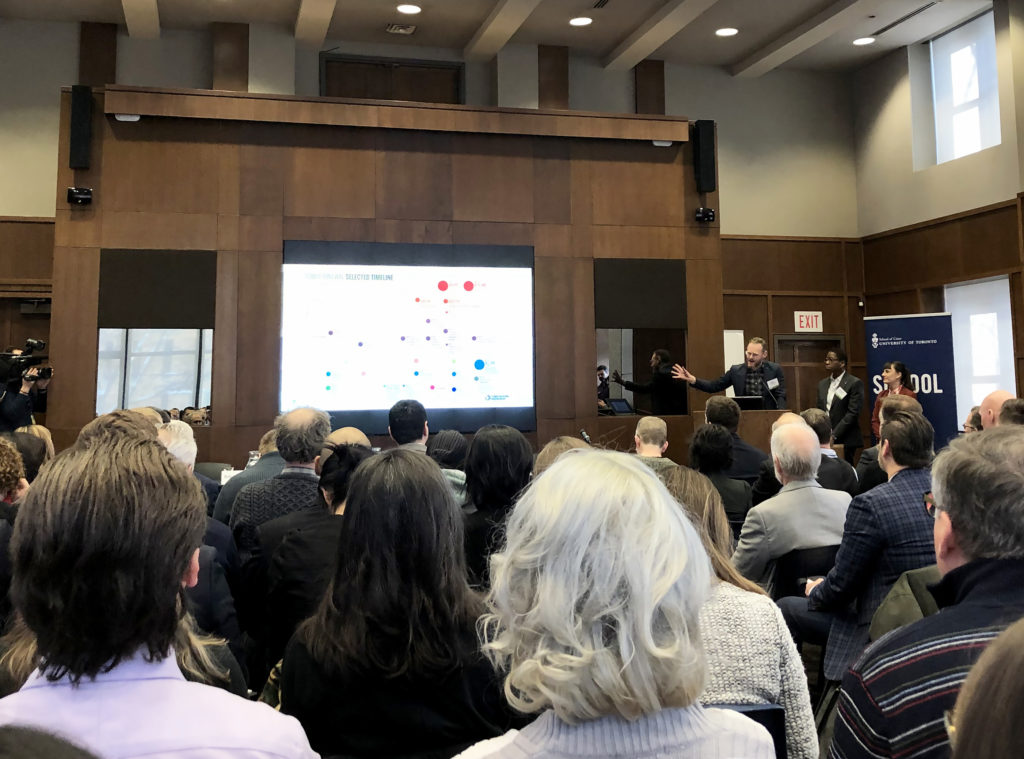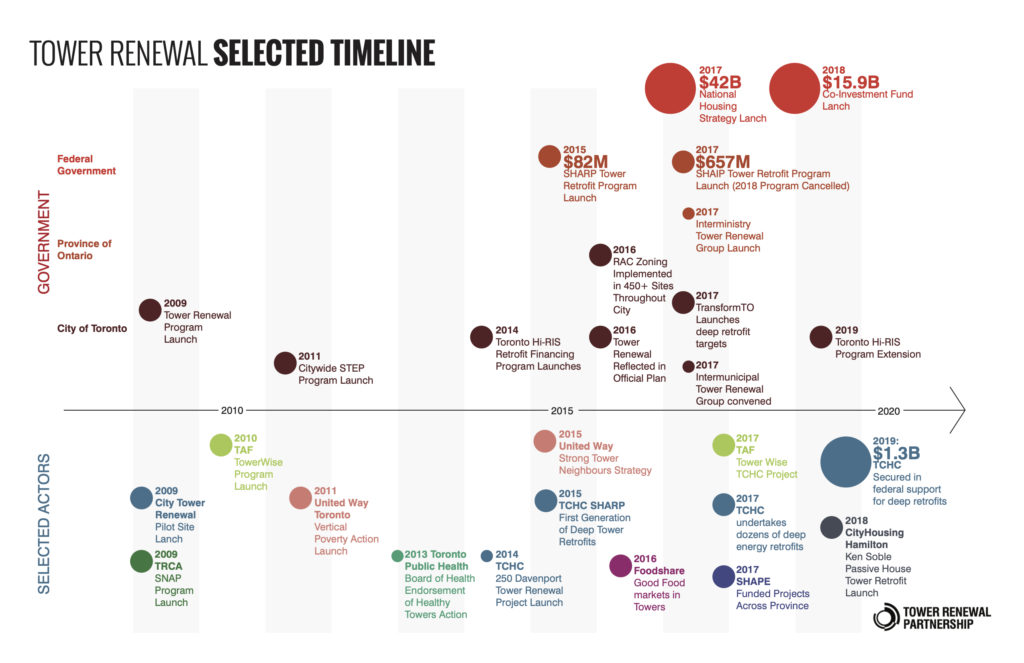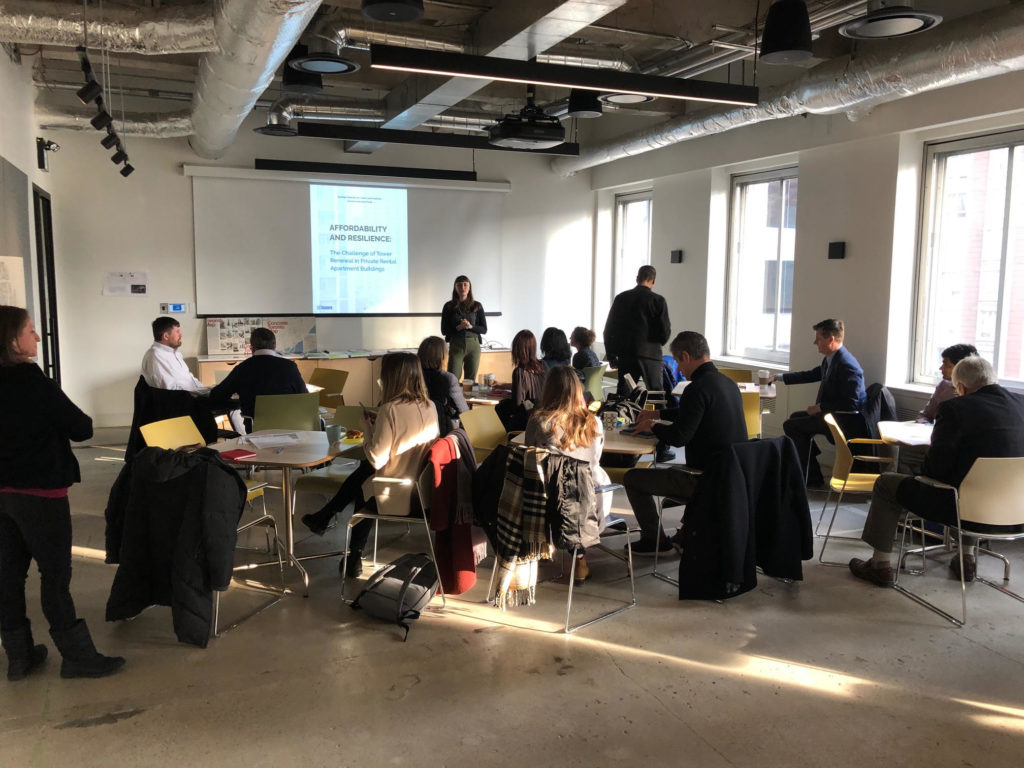The Tower Renewal Partnership and the City of Toronto recently partnered with the Urban Land Institute (ULI) to bring experts to Toronto for a weeklong visit to explore one of the biggest resilience challenges facing Toronto: retrofitting our aging apartment towers. Experts from across North America formed an Advisory Panel and visited Toronto during the week of February 24 to learn about Toronto’s challenges, meet with leaders on this topic, and make recommendations.
Watch the Advisory Panel’s presentation
As a co-host of the ULI Panel with the City of Toronto, the TRP team hosted a series of workshops and tours throughout the study week.
On the final day of their visit (February 28), a panel discussion was held at the Munk School of Global Affairs and several recommendations were made to the City by the ULI Panel for consideration in optimizing Toronto’s response to the Tower Renewal Challenge.

These municipally focused recommendations come at an crucial time, with growing Tower Renewal activity underway in the Toronto region, Federally and across the country. The following diagram illustrates key project milestones within the Greater Toronto over the past decade.

The ULI Panel recommendations are the result of a rapid and intense study process, and were generated to propel discussion, future research, and action.
A full list of recommendations can be found below:
- Accelerate Tower Renewal with a Big Public Tower Retrofit Program – starting NOW!
- Launch program in a more public way, with a commitment to TCHC’s 131 towers by 2030
- Set your employment goal – how many new workers will you need?
- Set your materials goal – how much will you buy?
- Be transparent in your progress – everything online, available for owners, tenants, city officials, and the public
- Jump Start Private Tower Retrofit with a Pilot Program
- Offer a generous grant for the first 10 early adopters. Match dollar-for-dollar retrofits over $2 million
- Pick projects that are multi-measure, have the biggest impact on resilience and the deepest improvements in energy efficiency
- Announce 10 pilot participants at ULI Spring Meeting (May 12-14 in Toronto)
- Commence pilot projects in 2021
- Pilots are a roadmap for how to cost-effectively execute
deep retrofits.
- Paying For It: Incentivizing higher levels of affordability and accessibility
- For owners willing to go above and beyond 5-year payback investments, government funding would require additional affordability, resilience, and accessibility requirements:
- Caps on rent increases for apartments that turn over
(maintaining long-term affordability) - Additional funding for a deeper investment in resilience, accessibility, and safety (than would be made without funding)
- Caps on rent increases for apartments that turn over
- With deeper investments in sustainability, accessibility, resilience, and safety that may not have a specific ROI to the owner, the city should provide financial support recognizing the value of these priorities to the city.
- For owners willing to go above and beyond 5-year payback investments, government funding would require additional affordability, resilience, and accessibility requirements:
- Tower Renewal Strategy:
- Towers are a gift!
- Use TCHC program as the learning platform
- Develop a skilled workforce
- Contribute to the local economy
- Become the world’s example of Tower Renewal
Overall Recommendations:
- Improve Resilience & Livability in Tower neighbourhoods: Capitalize on the spaces in between
- Reclaim and animate disused spaces between towers
- Expand and integrate the public realm
- Proactive and positive
- Collaborative organizational approach
- New “TEDs” – Tower Enhancement Districts
- Tower residents, tower owners, city, social service professionals, business, and institutions
- People-focused and place-based Facilities and facilitators
Strategic and intentional
- Create “Tower Enhancement Districts” (TEDs): Accelerate positive change in the spaces in between
- Tower Enhancement District
- Adapt and combine models – business improvement associations and residential master plan communities
- Participants – tenants, owners, social service providers, city, local institutions, businesses
- Funding
- City grant and/or tax improvement sources (seed funds)
- Tower owner parcel tax
- NGOs
- Philanthropy – corporate, civic, individual
- Local business resources
- Initiate now with minimal cost first steps
- Resilient, perpetual community organization
- Tower Enhancement District
- Animate the Spaces to Foster Community Resilience: Learn, grow, enjoy, strengthen, and support each other
- Better variety of spaces = better opportunities
- Employment, education, enjoyment
- Training, language and literacy, finance and budgeting, job readiness, technology, counselling, tutoring
- Small businesses
- More office and meeting space
- Social and recreational (night market, outdoor cooking, arts, clubs, play, and exercise)
- Emergency preparedness support – heating and cooling shelters
- Food – preparation & distribution, eating, urban
agriculture - House temporary exhibits and demonstrations of resilient technologies and materials, in open space
- Place-Based Organization: Frame the vision of local community resilience
- Develop a rubric for organizing in tower communitiesAddress full cycle of needs (not just crisis)
- Grassroots assessment of community needs and values
- Define pillars of resilience
- Wellness, employment, opportunity, household stability
- Articulate tower community resilience goals, and integrate
among city tools and plans- RAC (Residential Apartment Commercial) zone opened a tremendous opportunity in community hands
- Heighten tenant awareness of RAC zoning and methods to add new uses (permitting, construction)
- Accelerate extension of Enhancing Our Streets & Public Realm programs into tower places (street art & furniture, biodiversity, graffiti removal, complete streets)
- Intelligent Communication: Share technical data and success stories
- Communication messaging
- Promote success stories, share ingredients of success
- Promote culture of working together to deliver results
- Orient tenants to sustainability-driven changes around them
- Liaise with sustainability and construction activities across City
- Resources
- Tenants – crowdsource ideas for positive transformation
- Engage youth (resiliency over the long term)
- Engage youth (resiliency over the long term)
- Design & city planning community
- U. of T. – lab, seminar, studio, thesis, pilot, practicum, design competition, research
- U. of T. – lab, seminar, studio, thesis, pilot, practicum, design competition, research
- Global community of tower neighbourhoods
- Eastern Europe, Britain, around North America & beyond
- Integrated insights – technical, social, financial, political
- Eastern Europe, Britain, around North America & beyond
- Institutional memory – long term process and solutions
- Tenants – crowdsource ideas for positive transformation
- Communication messaging
- Increase Housing Supply: Tower Renewal strategies are not a substitute for an affordable housing strategy. The City of Toronto should facilitate increased new supply as it is critical to taking the pressure off of aging towers and to address a continually low vacancy rate.
- Remove barriers to rental housing production.
- Process changes: shorter, predictable, less expensive
- Make approval process shorter and more predictable
- Make approval process shorter and more predictable
- Reduce cost of housing development
- Right size parking requirements (near transit)
- Allow adequate density in appropriate locations
- Range of housing options should include mid-rise buildings
- Reduce tax and other financial barriers
- Process changes: shorter, predictable, less expensive
- Make rental housing construction more attractive
- Review HST regulations (condominiums vs. rental housing)
- Develop financing tools to increase construction loan proceeds
- Reduction in planning lead times will make rental more attractive
- Mid-rise typology delivers more quickly which increases returns
- Review HST regulations (condominiums vs. rental housing)
- Identify and plan sites
- Public: Identify all vacant/underutilized city-owned sites appropriate for residential development
- Nonprofit: Mission-based organizations have underutilized sites that can house program and housing
- Transit: Include housing at stations currently under
development. Landbank around future transit nodes for
workforce housing - Private Towers: Create neighbourhood master plans that are plug-and-play for developers of infill residential and other uses
- Public: Identify all vacant/underutilized city-owned sites appropriate for residential development
- Make Inclusionary Zoning program more robust
- Create city-wide inclusionary program tailored to different markets and density/transit contexts. Conduct market economic feasibility study to understand what each sub-market/geography can bear in terms of affordability. Create a menu of options (lower percentage of units at deeper affordability vs. higher percentage of units at moderate incomes)
- Address needs of different user groups (families as well as single and special needs populations)
- For mid-value and low-value locations, create lower cost financing tools (CMHC)
- In lower value/higher percentage affordability context,
gap/soft financing and/or property tax abatements (not permanent) will be needed for economic feasibility. - Ensure long-term affordability: 40-50 years minimum;
permanent preferred
- Create city-wide inclusionary program tailored to different markets and density/transit contexts. Conduct market economic feasibility study to understand what each sub-market/geography can bear in terms of affordability. Create a menu of options (lower percentage of units at deeper affordability vs. higher percentage of units at moderate incomes)
- Remove barriers to rental housing production.

